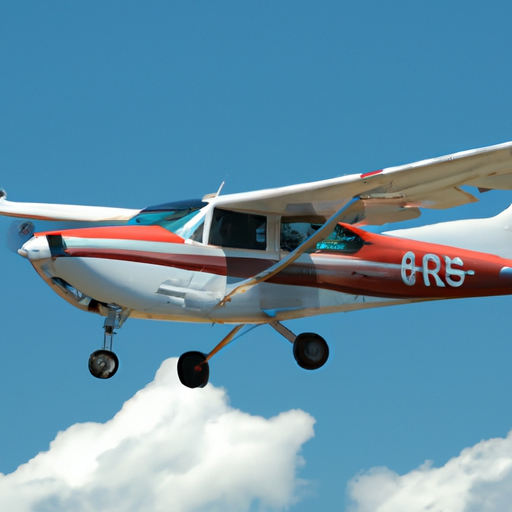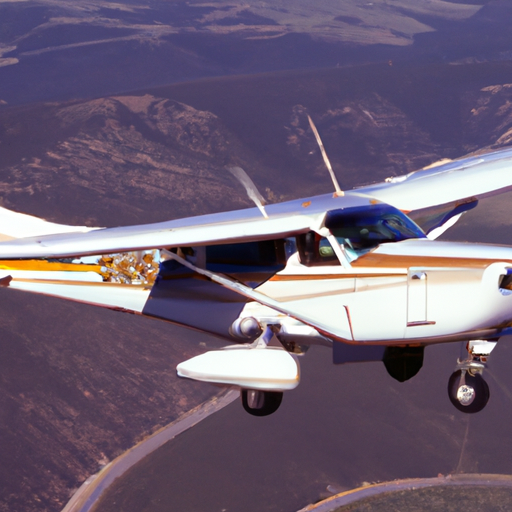
Have you ever wondered what it would be like to soar through the sky in your own private plane? Well, today I’m going to introduce you to the Cessna 305, a fantastic aircraft that can make your dreams of flying come true. In this article, we’ll delve into the details of the Cessna 305 and discover why it has become a popular choice among aviation enthusiasts. So, fasten your seatbelt and get ready to learn more about this incredible aircraft!
When it comes to the Cessna 305, there’s no shortage of reasons why it’s admired by pilots worldwide. This two-seat, single-engine plane has a sleek and stylish design that is bound to turn heads on the tarmac. But its beauty is not just skin deep. The Cessna 305 boasts impressive performance capabilities, with a maximum speed of over 100 knots and a range of 400 nautical miles. Whether you’re looking for a thrilling joyride or a reliable mode of transportation, this aircraft can do it all. Keep reading to uncover more about the features that make the Cessna 305 a standout choice for aviation enthusiasts like yourself!

Overview
The Cessna 305, also known as the Cessna L-19 Bird Dog, is a light observation and liaison aircraft that has played a significant role in aviation history. With a rich history, impressive specifications, and a range of uses and applications, the Cessna 305 has become a beloved and versatile aircraft. In this article, we will delve into the history, design, performance, safety features, pilot experience, uses and applications, ownership and maintenance, historical significance, and comparison to other aircraft of the Cessna 305.
History of Cessna 305
The Cessna 305 was developed in the 1950s as a replacement for the aging fleet of World War II liaison aircraft. It was designed by Cessna Aircraft Company to meet the needs of the United States Army, which required an aircraft that could perform various roles, including scouting, transportation of personnel, and artillery spotting. The prototype of the Cessna 305 first flew in 1949, and it soon gained popularity among military forces around the world.
Specifications of Cessna 305
The Cessna 305 is a single-engine, high-wing aircraft with seating for two occupants. It has a wingspan of 36 feet and 1 inch, a length of 25 feet and 9 inches, and a height of 9 feet and 3 inches. The maximum takeoff weight of the Cessna 305 is 2,450 pounds, and it has a range of approximately 300 nautical miles. The aircraft is powered by a Continental O-470-11 engine, which generates 213 horsepower.
Design and Features
Exterior Design of Cessna 305
The exterior design of the Cessna 305 is both sleek and functional. Its high-wing configuration allows for excellent visibility from the cockpit, making it ideal for observation and reconnaissance missions. The aircraft features a sturdy tricycle landing gear, which provides stability during takeoff and landing. The wings are equipped with standard navigational lights and flaps, which enhance the aircraft’s maneuverability and control.
Interior Design of Cessna 305
The interior of the Cessna 305 is designed with comfort and functionality in mind. The spacious cabin can accommodate two occupants, including the pilot and a passenger. The seats are ergonomically designed to provide maximum comfort during long flights. The cockpit is equipped with state-of-the-art avionics and navigation systems, ensuring a safe and efficient flying experience.

Performance
Engine Performance of Cessna 305
The Cessna 305 is equipped with a powerful Continental O-470-11 engine, which provides excellent performance and reliability. With its 213 horsepower, the aircraft can reach a maximum speed of 130 knots. The engine’s impressive power allows the Cessna 305 to climb at a rate of 850 feet per minute, enabling it to quickly reach cruising altitude.
Speed and Range of Cessna 305
The Cessna 305 has a maximum cruising speed of 105 knots and a range of approximately 300 nautical miles. Its fuel capacity of 43 gallons allows for extended flights without the need for frequent refueling. These specifications make the Cessna 305 suitable for a wide range of missions, including aerial photography, search and rescue, and patrol operations.
Fuel Efficiency of Cessna 305
Despite its powerful engine, the Cessna 305 is known for its fuel efficiency. With a fuel consumption rate of approximately 11 gallons per hour, the aircraft is cost-effective to operate. Its fuel efficiency, combined with its impressive range, makes the Cessna 305 an attractive option for both civilian and military operators.
Safety Features
Avionics and Navigation Systems of Cessna 305
The Cessna 305 is equipped with advanced avionics and navigation systems, enhancing the aircraft’s safety and operational capabilities. The cockpit features a multifunction display, which provides essential flight information and situational awareness to the pilot. The aircraft is also equipped with a transponder and a navigation system, allowing for precise navigation and communication with air traffic control.
Emergency Preparedness of Cessna 305
The Cessna 305 is designed with emergency preparedness in mind. It features a robust electrical system, ensuring that essential equipment such as radios and lights remain functional even in emergency situations. The aircraft is also equipped with emergency exit windows and doors, providing quick and easy access for occupants in case of an emergency landing.
Pilot Experience
Cockpit Layout and Controls of Cessna 305
The cockpit of the Cessna 305 is ergonomically designed to provide a comfortable and intuitive flying experience. The controls are well-positioned and easy to reach, allowing for precise handling of the aircraft. The instrument panel is uncluttered and easy to read, providing the pilot with essential flight information at a glance. The overall cockpit layout promotes efficient operation and reduces pilot workload.
Handling and Maneuverability of Cessna 305
The Cessna 305 is known for its exceptional handling and maneuverability. Its responsive controls and agile nature make it a joy to fly. The aircraft’s high-wing design provides excellent stability, even in windy conditions. Whether performing aerobatic maneuvers or navigating through tight spaces, the Cessna 305 offers pilots a thrilling and enjoyable flying experience.
Uses and Applications
Civilian Uses of Cessna 305
The Cessna 305 has a wide range of civilian uses. It is often utilized for aerial photography and surveying, as its excellent visibility and stability make it ideal for capturing high-quality images. The aircraft is also popular among recreational pilots, who enjoy its maneuverability and comfortable cabin. Additionally, the Cessna 305 is used for wildlife conservation efforts, as it can be equipped with specialized equipment for tracking and monitoring wildlife populations.
Military Applications of Cessna 305
The Cessna 305 has been extensively used by military forces around the world. Its role in artillery spotting, reconnaissance, and liaison missions has been invaluable. The aircraft’s maneuverability and impressive speed allow it to operate in various environments, including rugged terrains and hostile areas. The Cessna 305 has also been employed for search and rescue operations, thanks to its excellent visibility and capacity to carry emergency equipment.
Ownership and Maintenance
Cost of Owning a Cessna 305
The cost of owning a Cessna 305 depends on various factors, including the aircraft’s condition, maintenance history, and avionics configuration. On the used market, the price of a Cessna 305 can range from $50,000 to $150,000. It is important to budget for regular maintenance, inspections, and fuel costs when considering the ownership of a Cessna 305. Insurance and hangar fees should also be taken into account.
Regular Maintenance of Cessna 305
Regular maintenance is crucial for ensuring the safe and reliable operation of a Cessna 305. The aircraft should undergo routine inspections, including engine checks, propeller inspections, and avionics tests. Oil and filter changes, as well as other scheduled maintenance tasks, should be performed according to the manufacturer’s recommendations. Adhering to a comprehensive maintenance plan will help extend the aircraft’s lifespan and preserve its value.
Historical Significance
Role in Aviation History
The Cessna 305 has played a significant role in aviation history. It served as a vital liaison and observation aircraft during World War II and the Korean War. Its versatility and reliability earned it a place in the hearts of pilots and military personnel alike. The Cessna 305’s contributions to military operations and its enduring legacy in civilian aviation make it a truly iconic aircraft.
Notable Cessna 305 Models
There have been several notable models of the Cessna 305, each with its own unique features and capabilities. One such model is the Cessna L-19E Bird Dog, which featured improved avionics and increased payload capacity. The Cessna L-19E was widely used by the United States Army and other military forces for reconnaissance and liaison missions.
Comparison to Other Aircraft
Cessna 305 vs Cessna 172
The Cessna 305 and Cessna 172 are both popular aircraft in the general aviation community. While the Cessna 305 is primarily designed for observation and liaison missions, the Cessna 172 is a four-seat aircraft that is often used for training and recreational flying. The Cessna 305 offers better maneuverability and visibility, while the Cessna 172 provides more passenger capacity and a longer range.
Cessna 305 vs Piper Cub
The Cessna 305 and Piper Cub are two iconic aircraft that have left a lasting impact on aviation history. The Piper Cub is known for its simplicity and ruggedness, making it a favorite among recreational pilots. The Cessna 305, on the other hand, offers more advanced avionics and a higher cruising speed. While both aircraft have their strengths, the Cessna 305 is better suited for missions that require greater speed and maneuverability.
Conclusion
In conclusion, the Cessna 305 is a remarkable aircraft with a rich history and impressive specifications. From its role in military operations to its wide range of civilian applications, the Cessna 305 has proven itself to be a versatile and reliable aircraft. With its excellent performance, safety features, and pilot-friendly design, the Cessna 305 continues to be a beloved and respected aircraft in the aviation community.


Leave a Reply